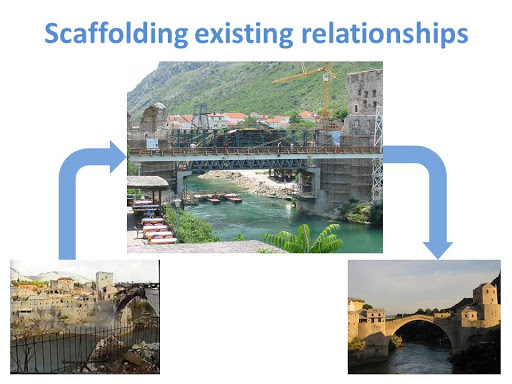29th March 2018

Pictured above: the repair of the famous Mostar bridge that was all but destroyed in the war that accompanied the break-up of former Yugoslavia.
Scaffolding existing relationships is one of the Core Features of AMBIT. Accordingly you will find Training Exercises for Scaffolding existing relationships in this manual.
There is constant effort to support, or add scaffolding to, key existing relationships:
- The young person's relationship to him or herself
- Relationships within the family
- Relationships between the family and other professionals in the network
- Relationships with key professionals in the network that may be of significant value, or likely to be longer lasting than ours
- The necessity of identifying any (rudimentary, or frail) StrengthsResiliencies that might easily be overlooked, and building on these
- The need for a practitioner to hold in mind the risk that out of good intentions (to become an important, helpful figure in a young person's life) I might inadvertently undermine a relationship that - although fragile, and perhaps even apparently unhelpful, actually holds a greater ambit for influencing positive change over the coming year(s) than I - or my team - do.
Wherever possible, security in existing Attachment Relationships is supported as being in the long term interests of the young person’s psychological development, even in settings that may conventionally be seen as high risk.
AMBIT stresses the importance of SocialEcology, and SystemsTheory, and supports an unwillingness to be drawn into Teleological thinking that attempts automatically to replace existing supportive structures. The focus in AMBIT is always on scaffolding what is there, so that fundamental structures (relationship to self, to family, close friends, School, Social Services, a Youth worker, etc) can be strengthened in ways more likely to sustain the task of maintaining an IntegrativeContext.
"Scaffolding is a major word we use - as in intensive treatment service, our CPNs see themselves as a temporary part of a young persons life and talk of scaffolding other workers in the network."Ambit-influenced team, 2014
But...
This is unless, of course, the level of Safeguarding or Child Protection concerns make this option inevitable - and it is not at all uncommon that a high degree of uncertainty surrounds such questions.Keeping a Balance:
Of course scaffolding relationships that may be far from ideal requires attention to Managing Risk... It is important to work with what is there, but not to lose sight of the need for careful Governance so that risks are managed and client, worker, and others are protected as much as possible....this is why Managing Risk is the stance item in the Core Features of AMBIT that is paired with Scaffolding existing relationships. See the AMBIT Wheel. At times we overbalance into too-rigid protocol-driven (Teleological thinking) risk management interventions that in the long term threaten our relationship with a young person, or their relationship with others who might actually still be in their lives long after we have left the scene. At other times, a diligent worker's compassion and empathy may lead them to over-identify with the young person, or "up-regulate" their tolerance of risk ("maybe it's just me being too much of a worrier, or getting old and not understanding how young people live these days - who am I to wade in and tell people they are wrong?") |
What to do?
See particularly:- An approach to assessing what is there: the Multi-Domain Assessment and in particular the Narrative History and StrengthsResiliencies are key.
- Social-Ecological Work for building resiliencies in a young person's life
- MentalizationBasedWork for work on a young person's relationship to themself and others
- FamilyWork for work on family relationships that might be improved